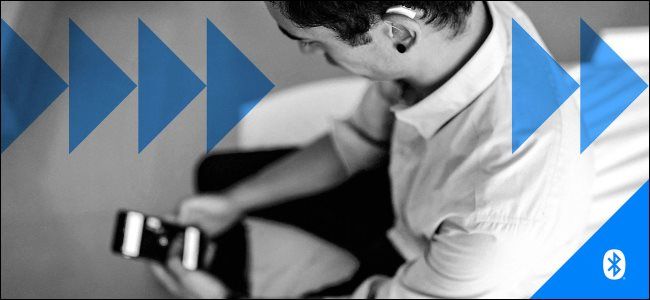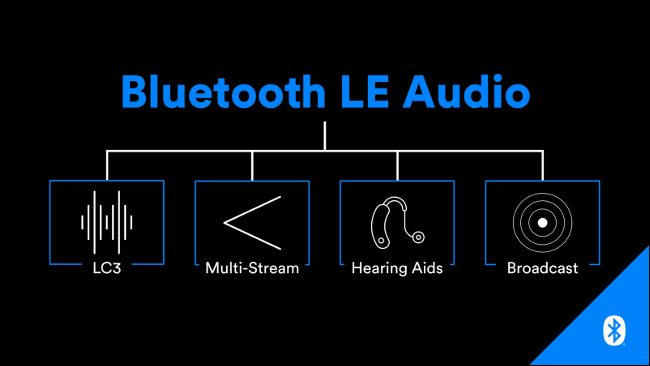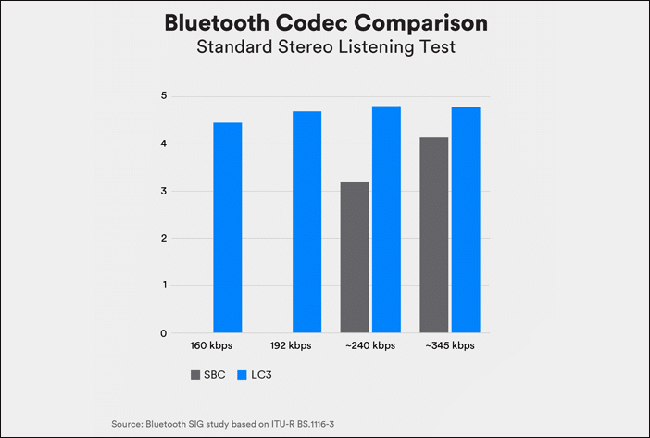Quick Links
Wireless headphones are already worth the money, and soon, they'll be even better. Bluetooth LE Audio promises a new high-power, low-energy audio codec. You can expect longer battery life, the ability to stream to multiple sets of headphones simultaneously, and more!
What Is Bluetooth LE Audio?
Bluetooth Low Energy (LE) Audio is a new standard for low-power audio transmission over Bluetooth. It's separate from Bluetooth 5 and 5.1. The Bluetooth Special Interest Group (SIG)---a community of over 34,000 companies that produce and design products that use wireless technology---announced Bluetooth LE at CES 2020.
In addition to lower energy consumption, the new Low Complexity Communications Codec (LC3 for short), which was co-developed by the Fraunhofer Institute for Integrated Circuits and Ericsson, promises improvements in audio quality over the existing SBC Bluetooth codec.
"Extensive listening tests have shown that LC3 will provide improvements in audio quality over the SBC codec included with Classic Audio," said Manfred Lutzky from Fraunhofer IIS. "Even at a 50 percent lower bit rate."
Bluetooth LE Audio also introduces several new features, including multistream audio, the ability to "broadcast" via Bluetooth to multiple devices, and future integration with hearing aid devices for more seamless accessibility options.
Hasn't Low Energy Bluetooth Been Around for a While?
Bluetooth Low Energy isn't a new technology, but Bluetooth Low Energy Audio is. Low Energy integrated circuits appeared as early as 2009, but overcoming the hurdle of high bandwidth requirements for audio transmission took another decade of development.
Many products on the market, like wearables, smartphones, and medical devices, already use standard Bluetooth LE. However, these devices transmit relatively small amounts of data, without the added complexity of dealing with latency and audio compression.
The LC3 codec is at the heart of Bluetooth LE Audio. Now that Low Energy Audio has been standardized by the Bluetooth SIG, we can look forward to device manufacturers supporting it in future products.
New Features You'll Get with Bluetooth LE Audio
Bluetooth LE Audio isn't just about improved power efficiency. The technology enables some exciting new features, while improving existing Bluetooth audio standards.
Connect to Multiple Sources Simultaneously
With Bluetooth LE Audio, you can connect a single pair of headphones to multiple devices at the same time. This should allow you to receive audio from multiple sources, without having to bounce between devices.
This is possible thanks to the way multiple streams were implemented in the new LE Audio standard. Currently, device manufacturers must overcome single-stream limitations when they design wireless headphones. In the case of truly wireless earbuds, for example, only one earbud connects to the source directly.
This can result in increased latency, patchy audio, and dropouts because both earbuds are forced onto one channel. Many of the tricks required to implement voice-activated assistants and two-way audio communication will no longer be necessary thanks to synchronized multistream audio.
In practice, this could allow you to do things like listen to a baby monitor, take a phone call, and use a smart assistant like Alexa, all from one set of Bluetooth headphones.
Connect One Source to Multiple Bluetooth Devices
Also, you'll theoretically be able to connect to an unlimited number of in-range devices from a single source. This is similar to (but better than) Apple's new "Share Audio" feature, which allows AirPods and Beats owners to share audio with two sets of headphones.
Due to the way the standard was designed, the source audio won't be interrupted when you connect a new device. This will allow listeners to drop in and out at will.
If you've ever wanted to host your own silent disco, Bluetooth LE Audio will make it easier than ever!
Broadcast Bluetooth Audio Like Wi-Fi
Building on the ability to serve source audio to multiple Bluetooth listening devices, you could compare the new "broadcast" feature to Wi-Fi. Just like when you scan a public space, like an airport, for available wireless networks, Bluetooth LE Audio will allow you to listen to streams in a similar way.
You can passcode-protect your stream if you want to broadcast privately or leave it open to anyone who wants to listen.
These streams could make it easy to tune in to foreign language audio tracks at a movie theater, or listen to the sound of a silenced TV in an airport lounge through your earphones. You could take a sightseeing tour and, if the museum uses this technology, enjoy the tour guide's audio over your own headphones.
Better Accessibility for People with Hearing Loss
Bluetooth LE Audio fully supports hearing aid development standards and could make it possible to pass audio directly from a source to a hearing aid, or even a whole room full of people with hearing aids.
Within the next decade, most TVs could be equipped with modern hearing aids, making them ideal for millions of people with hearing loss, right out of the box.
What Does Bluetooth LE Audio Mean for Devices?
Because Bluetooth LE Audio using the LC3 codec is around twice as power-efficient as Bluetooth audio using the existing sub-band codec (SBC), it makes two things possible for devices that implement the technology.
First, devices could be smaller without sacrificing runtime, and second, battery life could be improved significantly without additional size or weight.
However, Bluetooth LE Audio will coexist alongside the Classic Audio standard. It will be up to device manufacturers to implement the right technology for the job.
Higher bitrate audio will likely sound best using over Classic Audio SBC, though, so don't expect all high-end Bluetooth headphones to switch over to the new Low-Energy standard.
When Will Bluetooth LE Audio Hardware Be Available?
Since the new standard was just announced in early January, there aren't yet any devices on the market that support it. Bluetooth SIG said this will change in 2020 as manufacturers bring their devices to the market.
Don't expect to see LE Audio "Broadcast" features implemented for a few years, though. The technology isn't expected to launch fully until 2021. It will also take venues some time to catch up, but by the time they do, there should be plenty of compatible devices on the market.
A Game-Changing Technology
Bluetooth Low Energy Audio represents a leap forward in wireless audio streaming technology that could change the way we interact with the world.
You should expect more smartphone manufacturers to ditch the headphone jack as technology like LE Audio makes its way onto the shelves.





